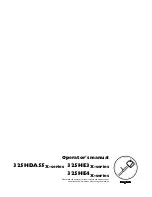
85
WARNING
Read all the safety precautions and instructions. Failure to comply with the
safety precautions and instructions may result in an electric shock, fire and / or
severe injuries.
Keep all the safety precautions and instructions for the future.
Only pass on your electric power tool together with these documents.
Special safety instructions
Hold the appliance using the insulated handles when performing work where
the tool could come into contact with hidden power lines. Contact with live
wires can also apply voltage to metallic appliance parts and cause the user to
receive an electric shock.
When the machine is not being used, lock it using the safety lock (4) to ensure
it is not switched on unintentionally. Remove the battery pack from the machi-
ne before making any adjustments, upgrade, performing maintenance or clea-
ning.
Make sure that the machine is switched of before inserting the battery pack.
Always wear protective glasses, work gloves and sturdy shoes when working
with your machine.
Make sure that there are not any power, water or gas lines in the place you
want to work on (e.g. using a metal detector).
When sawing water pipes, make sure they do not contain any water.
Wear hearing protection when working for a longer period of time. Prolonged
exposure to high noise levels can lead to hearing damage.
WARNING
:
Some dust created by power sanding, sawing, grinding, drilling, and other
construction activities contains chemicals known to cause cancer, birth defects
or other reproductive harm. Some examples of these chemicals are:
- Lead from lead-based paints,
- Crystalline silica from bricks and cement and other masonry products, and
- Arsenic and chromium from chemically treated lumber.
Your risk from these exposures varies, depending on how often you do this
type of work. To reduce your exposure to these chemicals: work in a well ven-
tilated area, and work with approved safety equipment, such as those dust
masks that are specially designed to filter out microscopic particles. This also
applies to dust from other materials such as some timber types (like oak or
beech dust), metals, asbestos. Other known diseases are e.g. allergic reac-
Translation of the original instruction
















































